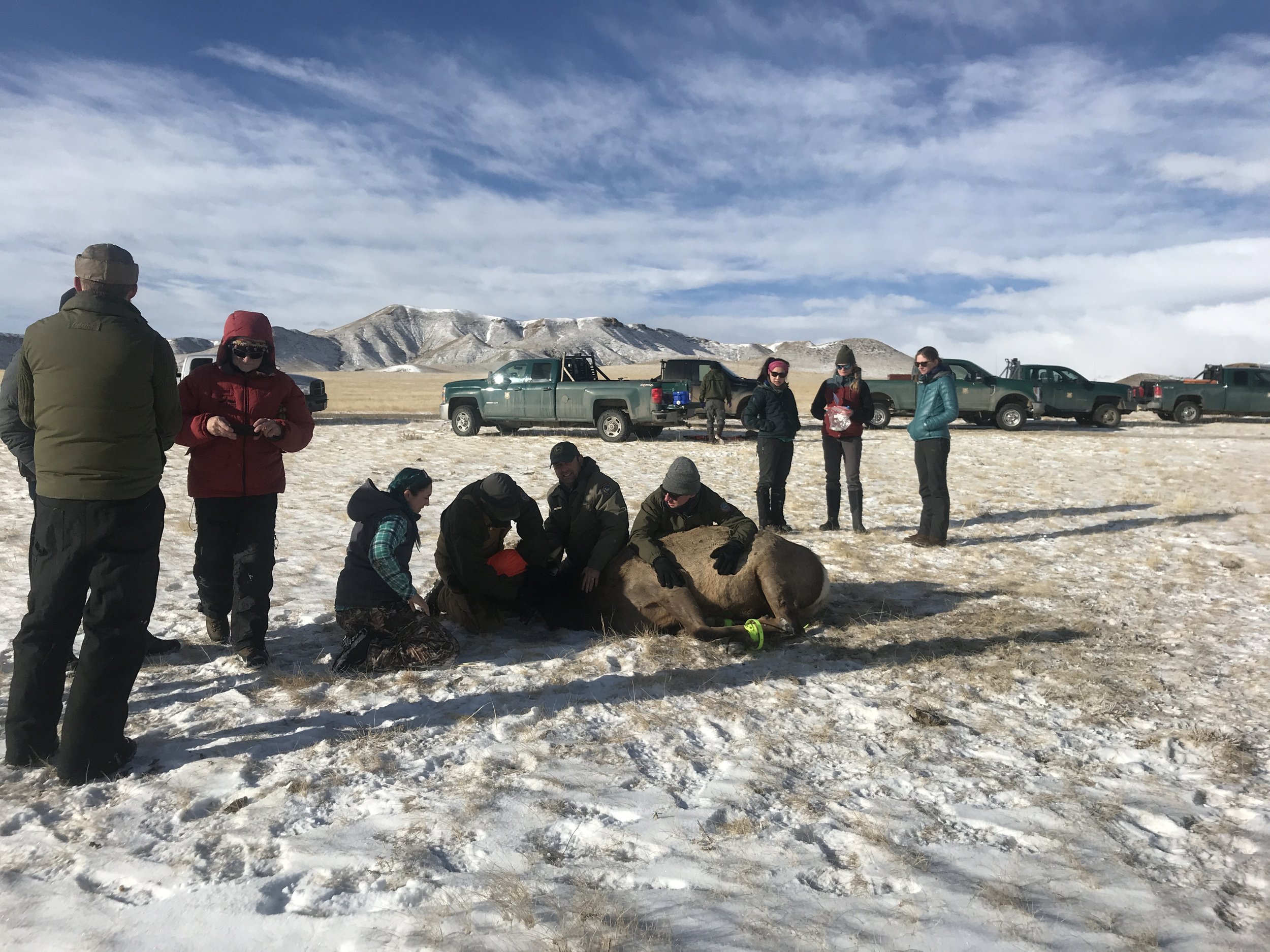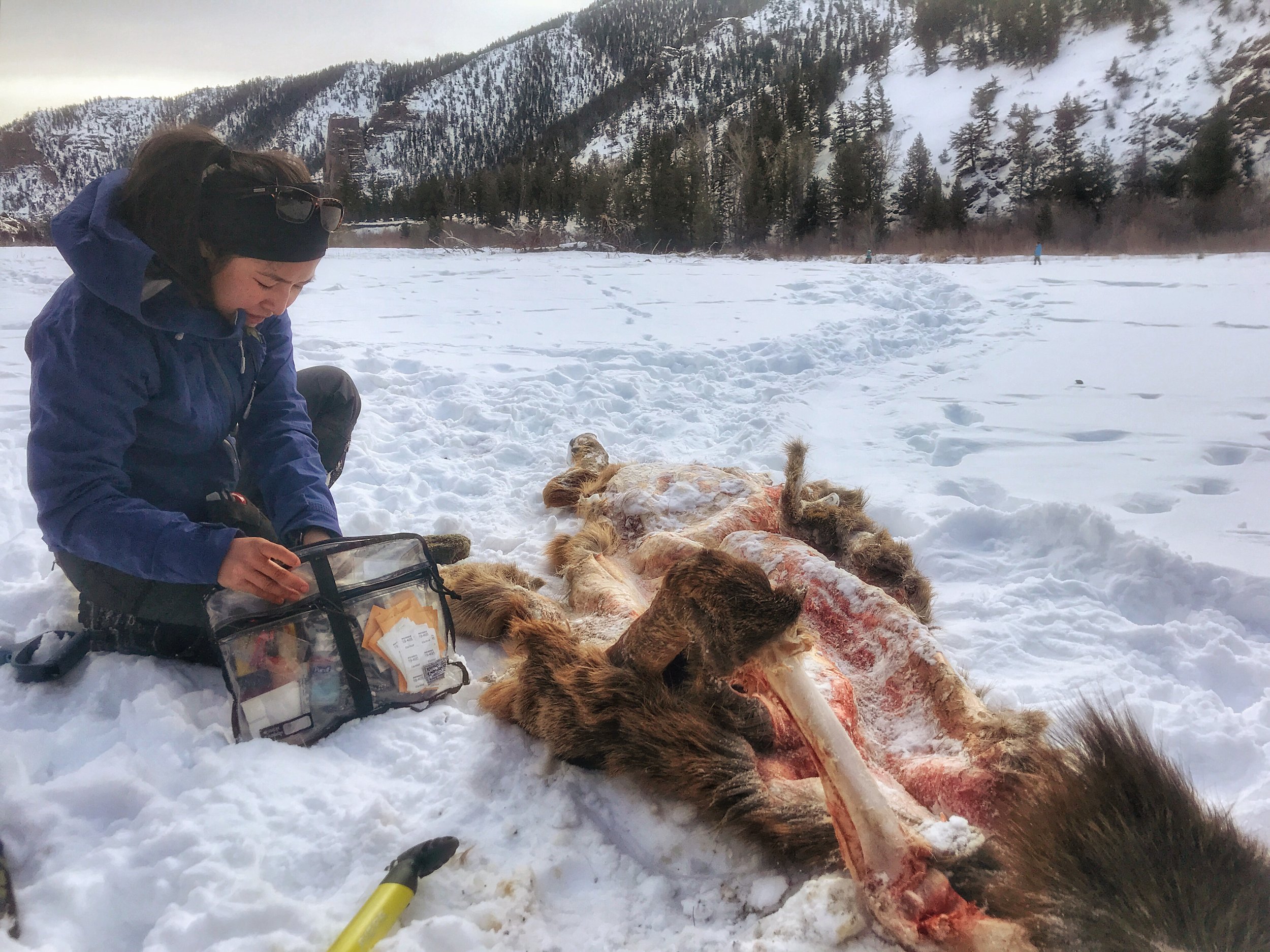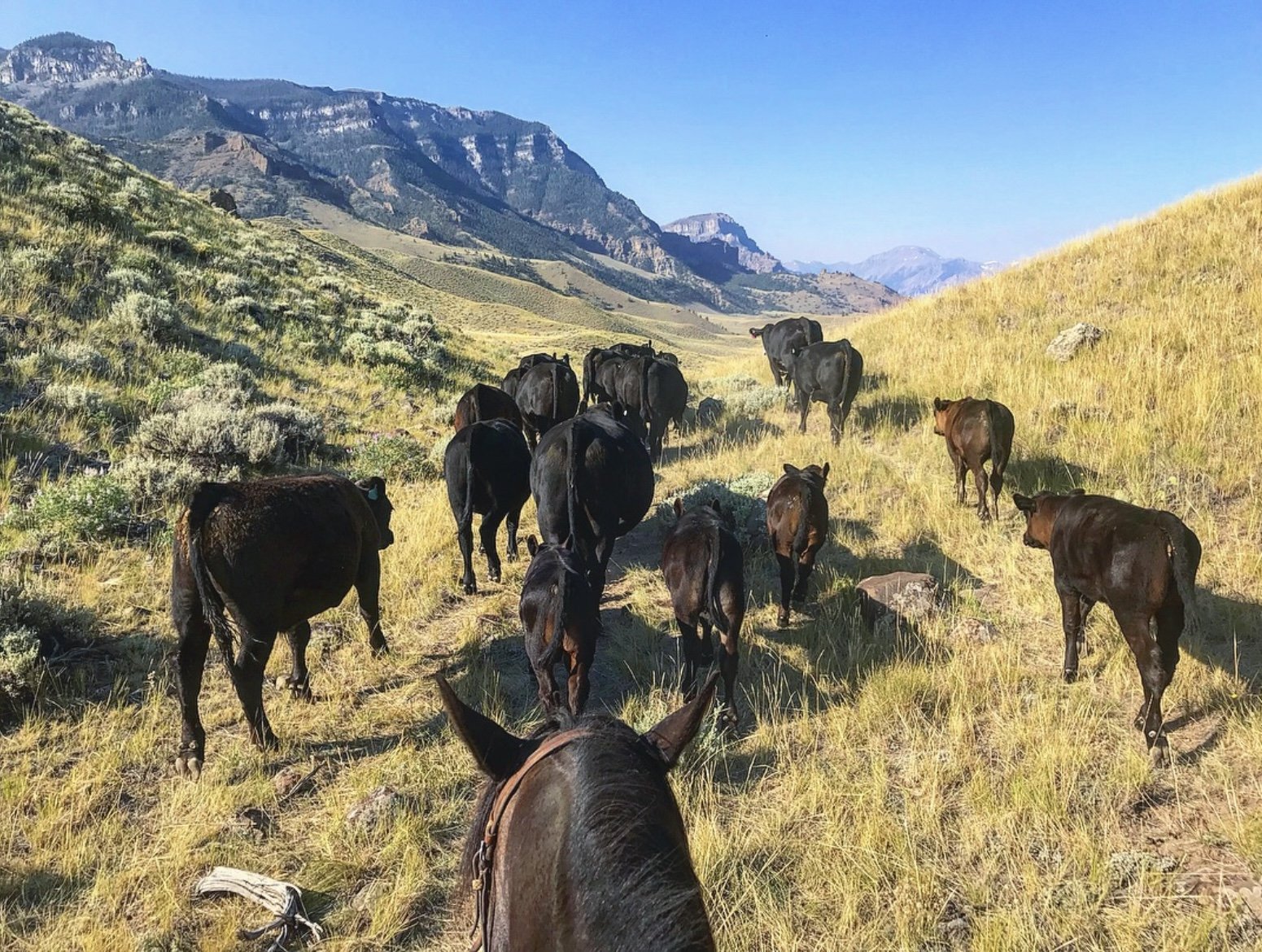Interdisciplinary research on the ecological and social dimensions of wolf-livestock conflict
My PhD research focused on the ecological drivers and social challenges of wolf-livestock conflict in the eastern Greater Yellowstone Ecosystem near Cody and Meeteetse, Wyoming.
Because wolf-livestock conflict is such a complex and multifaceted issue, a variety of data is needed to address the drivers, patterns, and challenges of conflict.
During my PhD, I collaborated with ranchers, landowners, wildlife managers, researchers, and conservation NGOs to collect elk and wolf movement data, wolf predation and diet data, and qualitative data from in-depth interviews. My research interests include predator-prey interactions, migration movement & behavioral ecology,& qualitative research using grounded theory methods. Although I am still currently working on publishing my PhD research in peer-reviewed scientific journals, you can access my dissertation online here.
I am dedicated to connecting diverse groups of people engaged in wildlife conservation on working lands, including:
Translating technical research findings from scientists to policymakers & practitioners making management decisions & implementing on-the-ground initiatives;
Sharing the knowledge & experiences of people who share the landscape with large carnivores & using storytelling to build connection with the public & bridge the urban-rural divide;
Communicating between ecologists & social scientists to ensure research includes & supports the interests of both people & wildlife.
PREDATOR-PREY MOVEMENT ECOLOGY - MIGRATORY COUPLING OF WOLVES & PARTIALLY MIGRATORY ELK
One of my main research questions is: “how do elk migrations affect patterns of wolf-livestock conflict?”. In the Greater Yellowstone Ecosystem, migratory elk herds move between high elevation summer ranges in Yellowstone and adjacent low-elevation winter range on working lands such as ranches and other private lands. These large elk herds attract predators such as wolves and grizzlies, which can lead to conflict with people and livestock. However, recent research has found that less elk in the GYE are migrating and more are remaining on their winter ranges. This is because the costs of migration have increased (e.g., climate change making it more difficult to track the vegetation green-up, habitat fragmentation increasing the difficulty of moving across the landscape, increased predation on summer ranges and migratory routes from recovering grizzlies and wolves, etc.), while the benefits of remaining resident have increased (e.g., increased availability of year-round forage from agricultural crops, lower densities of wolves and grizzlies, etc). As patterns of elk migration change, we want to gain a better understanding of how predators like wolves may respond to these changes and what that could mean for wolf-livestock conflict.
To address this, I first analyzed the movement patterns of the Cody elk herd and the wolf packs that track it using GPS collar data. In 2019, 2020 and 2021, our research group worked with Wyoming Game & Fish and Native Range capture crew to deploy GPS collars on wolves and elk. Wildlife captures and handling were approved by University of California Berkeley’s Institutional Animal Care and Use Committee AUP-2018-07-11261. Below are several photos showing the wildlife capture and GPS collar deployment process.
Read the open access peer-reviewed paper in Current Biology here: https://www.sciencedirect.com/science/article/pii/S0960982225008814
Shawler, A.L, Barker, K.J., Xu, W., Mills, K.J., Mong, T.W. & Middleton, A.D. (2025). Wolves use diverse tactics to track partially migratory prey. Current Biology. 35(16). 4035-4042. https://doi.org/10.1016/j.cub.2025.07.015
SEASONAL PATTERNS OF WOLF PREDATION & DIET IN RESPONSE TO ELK MIGRATION
I then investigated how predation and diet patterns of wolves that prey on the Cody elk herd change when the majority of the herd migrates into Yellowstone and the Thorofare Wilderness of the Shoshone and Bridger-Teton National Forests. My crew and I spent six field seasons (3 winter, 3 summer) cluster searching - a protocol focused on investigating clusters of wolf GPS points to determine wolf activity and prey composition. Most clusters were wolf bed sites (because wolves nap a lot) or unknown activity when we could find any wolf evidence. But whenever we found a carcass at a cluster, we conducted a necropsy (i.e, autopsy on an animal) to collect data on wolf predation (i.e., what wolves actually killed), versus carcasses wolves scavenged that died of other causes (e.g., roadkill, grizzlies, malnutrition). We put in over 1,800 miles of hiking, snowshoeing, skiing, post-holing and riding horses to follow where the wolves have been.
We also collected wolf scat at clusters and at wolf homesites and conducted a diet analysis. This will be especially helpful for getting a better picture of what wolves eat in the summer since finding carcasses of smaller prey such as elk calves or deer fawns is difficult because wolves can consume them quickly or carry most of the carcass back to the den or rendezvous sites for the pups. We worked with partners at the Draper Natural History Museum at the Buffalo Bill Center for the West in Cody to analyze wolf scat, which involved many hours of sifting through prey remains and looking at hairs under a microscope to identify prey species.
I had the privilege of working with amazing field technicians including Stephi Matsushima, April Wood, Jenny Green, Danielle Deming, Will McDonald, Hannah Booth, Lisa Lochner, and Celeste Governale. Our summer field seasons would not have been possible without the help of Livingston Outfitters - especially Rick Roach, John Davis and Lee Livingston. Wyoming Game and Fish Department and Buffalo Bill Center of the West have also been important collaborators and supporters of this research.
QUALITATIVE RESEARCH METHODS TO INVESTIGATE THE CHALLENGES WOLF-LIVESTOCK CONFLICT MITIGATION
To address the social dimensions of wolf-livestock conflict, I conducted semi-structured interviews between 2021 and 2023 to better understand the socioeconomic barriers to managing and mitigating conflict. I interviewed ranchers, wildlife managers, outfitters and NGO folks who have had experience dealing with wolf-livestock conflict in the Cody area. This research was supported by the USDA National Institute for Food & Agriculture (NIFA) Pre-doctoral Fellowship.
Stay tuned for my published dissertation chapters!
Peer-reviewed Publications
Google Scholar profile link
Shawler, A.L, Barker, K.J., Xu, W., Mills, K.J., Mong, T.W. & Middleton, A.D. (2025). Wolves use diverse tactics to track partially migratory prey. Current Biology. 35(16). 4035-4042.
https://doi.org/10.1016/j.cub.2025.07.015
Tucker, M. A., Schipper, A. M., Adams, T. S., Attias, N., Avgar, T., Babic, N. L., ...Shawler, A.L.,…. & Mueller, T. (2023). Behavioral responses of terrestrial mammals to COVID-19 lockdowns. Science, 380(6649), 1059-1064.
Xu, W., Barker, K., Shawler, A., Van Scoyoc, A., Smith, J.A., Mueller, T., Sawyer, H., Andreozzi, C., Bidder, O.R., Karandikar, H., Mumme, S., Templin, E., & Middleton, A.D. (2021). The plasticity of ungulate migration in a changing world. Ecology, p.e03293.
*Wilkinson, C., McInturff, A., Miller, J., Yovovich, V., Gaynor, K., Calhoun, K., Karandikar, H., Martin, J., Parker-Shames, P., Shawler, A., Van Scoyoc, A., & Brashares, J. (2020). ecological framework for contextualizing carnivore-livestock conflict. Conservation Biology. 34(4), 854-867.
*The 2021 Wildlife Society Wildlife Publication Award in the Student Paper category
















